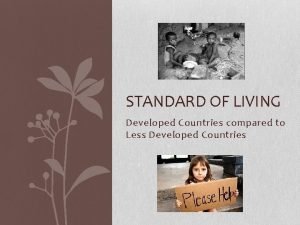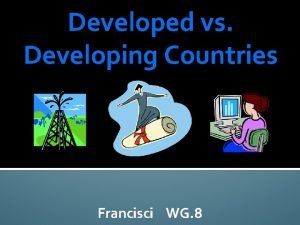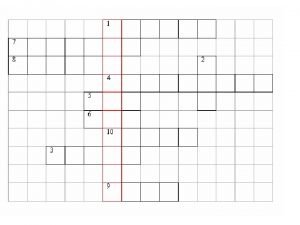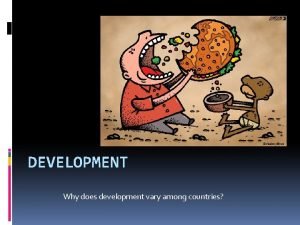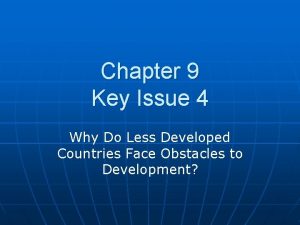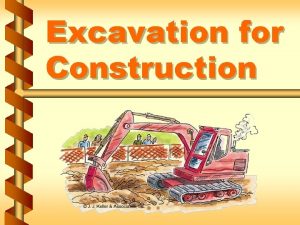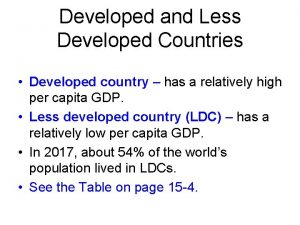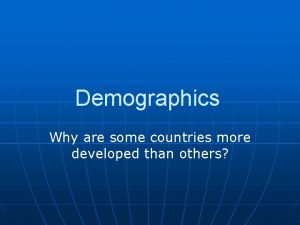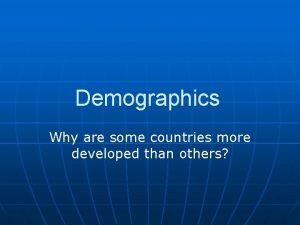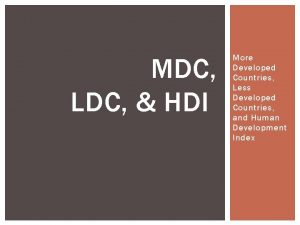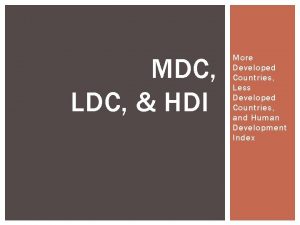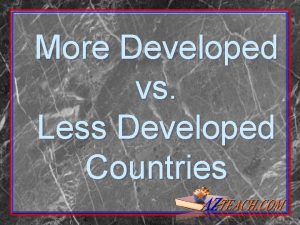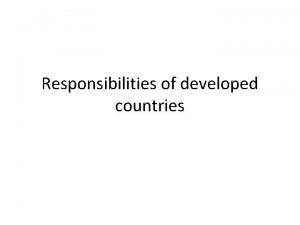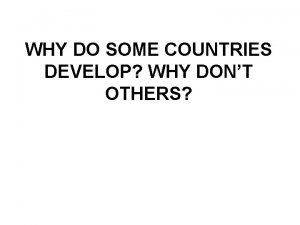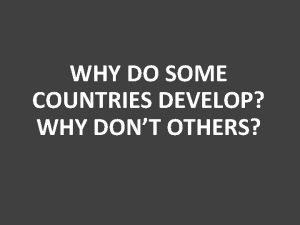Engage Activity Why are some countries more developed








































- Slides: 40

Engage Activity Why are some countries more developed than others?

Economic Development

What is Economic Development? • A measure of the welfare of people in a society that tells how advanced an economy is. Development is not purely an economic phenomenon but rather a multidimensional one.

We used to label countries as 1 st, 2 nd, and 3 rd world. This originated after WWII. • The 1 st world was the U. S. and its allies. • The 2 nd world was the USSR and its allies. • The 3 rd world was the remaining countries, which were unaligned and had less political and military power. 3 rd 1 st 2 nd

This terminology is now considered politically incorrect, so we say “more developed country” (MDC), “less developed country” (LDC), and “least developed country (or land-locked developing country)” (LLDC). More Developed Less Developed

What is Economic Development? • Countries are classified into 3 categories – More Developed (MDC) – Less Developed (LDC) – Least Developed Country (LLDC) - or Land-locked developing country (LLDC) • Based on the country’s Human Development Index (HDI)

More Developed Countries • Countries with a modern industrial society, well advanced economy, and a higher standard of living

More Developed Countries • MDCs usually share some other common features, including: – a highly industrialized society with modern technology – efficient transportation and communication systems – commercial agriculture – urban population – high per capita GNP (gross national product),

Less Developed Countries • Countries with less advanced technologies and lower standards of living

Less Developed Countries • LDCs usually share some other common features, including: – Low GDP per capita – Exhibits lowest indicators of economic development – Lowest HDI ratings of all the countries in the world – Large % of population in agriculture – Poor infrastructure

Least Developed Countries • Identified in 1984 as the 36 “poorest” countries in the world with very low per capita income (less than $250 US/year), very low literacy rates and almost no manufacturing industries.

Least Developed Countries LLDCs share most common features with LDCs, except (you know)…they’re lower.

Analyze the images Below Country A Country B

Newly Industrialized Countries • Countries that are moving from less to more developed economies

Newly Industrialized Countries • NICs usually share some other common features, including: – Increased social freedoms and civil rights – Strong political leaders – Shift from agricultural to industrial economies – Increasingly open-market economy – Multinational corporations – Strong capital investment from foreign countries – Lowered poverty rates

Human Development Index • Numerical index developed by the United Nations • Ranks countries based on development issues, progress, and policies • Looks at a number of factors – Demographic indicators – Economic indicators – Social indicators – Political indicators

HDI, 2001

Demographic indicators • • Life expectancy Birth rate Death rate Infant mortality rate

Life Expectancy • Life expectancy (M, F): The average number of years a newborn infant can expect to live under current mortality levels. (Canada = 79, 83)

Infant Mortality • Infant Mortality: the annual number of deaths of infants under age 1 year per 1, 000 live births. A country, which has less than 50 per 1, 000, is said to have conquered hunger. (Canada= 4. 8 per 1, 000)

Population Doubling Time • • • Population and Population Double Time: the number of years it would take for the population to double if the rate of natural increase remained constant. (Canada= 35 million people, doubles in 78 years. ) The growth rate can be used to determine a country or region or even the planet's "doubling time, " which tells us how long it will take for a country's current population to double. This length of time is determined by dividing the growth rate into 70. The number 70 comes from the natural log of 2, which is. 70. Given Canada's overall growth of 0. 9%, we divide 70 by. 9 (from the 0. 9%) and yield a value of 78 years. Thus, in 2093, if the current rate of growth remains constant, Canada's population will double from its current 35 million to 70 million.

True or False: A more developed nation has a high birth rate, high infant mortality rate, and a short life expectancy.

Economic Indicators • • • GDP per capita GNP per capita employment rate # of automobiles per capita • # of computers per capita • # of telephones per capita • # of televisions per capita

GNP per Capita • GNP per capita: total goods and services produced by a country divided by its population. This is the most typical indicator of economic development. (Canada = $42 610)

True or False: An LDC has a low GNP per capita income.

Small Group Discussion How do GNP and HDI differ? What are the pros and cons of using these indicators to determine the level of development of a country?

Social Indicators • • Literacy rates % attending college # of professionals Housing • Water supply • Sanitation • Access to basic services

Literacy Rate Literacy rate: % of people over the age of 16 who can read and write. (Canada = 99%)

Population/physician: the total population divided by the number of doctors. (Canada = 454/1)

• % of people employed in agriculture: the # of people involved in agriculture indicates subsistence (more farmers) vs. commercial (less farmers) and industrial vs. non-industrial. (Canada = 2%)

• Subsistence Farming: people grow only enough for their own family’s or village’s needs. They grow food to eat, not sell.

• Commercial Farming: farmers raise crops and livestock to sell in the market. Modern equipment makes these farmers more productive, so there are fewer farmers as a percentage of the work force. Characteristic of developed nations.

True or False: A less developed nation has a high literacy rate and a small number of doctors and hospitals to serve the population.

Political Indicators • • • Freedoms enjoyed Type of governance Voting rights Level of human rights impact of colonialism Degree of government oppression • Level of tolerance for different points of view

Physical Indicators • climate • access to water (landlocked) • natural disasters • availability of natural resources

The North-South Gap • • • coined by the UN in 1980. refers to the division of the economic world based on physical geography: many wealthy countries are found in the northern hemisphere; whereas a multitude of poorer countries are found in the southern hemisphere. great disparities exist in the range of social and economic development between the North & South. Many poorer nations are chastised, by the wealthier countries, for trying to improve themselves as the result has often led to international instability. Causes include: – colonialism and neo-colonialism Colonialism • An economic system in which a dominant “mother country” maintains control over the direction, organization, capital, investment, technology, and manufactured products of the dependant colony which in turn supplies raw materials, agricultural products, and cheap labour. Neo-colonialism • Economic imperialism; the control of Northern economic forces over newly independent countries in the South.


West Wing Clip • https: //www. youtube. com/watch? v=v. VXPr. BRt. TY

HDI Classification Activity • Select four countries: – – • • Canada A country with high human development A country with medium human development A country with low human development In a table, identify and list the components of the HDI (life expectancy, literacy rate, GDP per capita, birth rate, infant mortality rate, type of government, and population per doctor) Rank the countries according to their respective HDIs

Small Group Discussion • Explain the relationship between each indicator and economic development. • Discuss the consistency of relationship between their HDIs and the HDI components. • If you were to judge the country by its GDP or GNP only, would it still have the same level of development? Why?
 More more more i want more more more more we praise you
More more more i want more more more more we praise you More more more i want more more more more we praise you
More more more i want more more more more we praise you Antigentest åre
Antigentest åre Mdc more developed countries
Mdc more developed countries Why are some countries poorer than others
Why are some countries poorer than others Who is this?
Who is this? Pictures
Pictures Comparative education in developing countries
Comparative education in developing countries Less developed countries
Less developed countries What is a developing country definition
What is a developing country definition Why do some earthquakes cause more damage than others
Why do some earthquakes cause more damage than others We learn more different countries
We learn more different countries Why was the gps network originally developed
Why was the gps network originally developed Unix protection
Unix protection Dont ask
Dont ask Why does development vary among countries
Why does development vary among countries Formula for rank size rule
Formula for rank size rule Key issue 4 why do countries face obstacles to development
Key issue 4 why do countries face obstacles to development Why does development vary among countries
Why does development vary among countries They say it only takes a little faith
They say it only takes a little faith Sometimes you win some
Sometimes you win some Ice cream count or noncount
Ice cream count or noncount Contact forces
Contact forces Some say the world will end in fire some say in ice
Some say the world will end in fire some say in ice Some say the world will end in fire some say in ice
Some say the world will end in fire some say in ice Some trust in chariots and some in horses song
Some trust in chariots and some in horses song Engage explore explain elaborate evaluate
Engage explore explain elaborate evaluate Engage explore explain elaborate evaluate
Engage explore explain elaborate evaluate Engage
Engage High potential employee development best practices
High potential employee development best practices Esa engage study activate
Esa engage study activate Engage in excavation
Engage in excavation My wiggly amps
My wiggly amps Cli engage
Cli engage Objective of supervision
Objective of supervision Interruptive listening
Interruptive listening Engage new york kindergarten
Engage new york kindergarten Questioning strategies to engage all learners
Questioning strategies to engage all learners Psu harrisburg engage
Psu harrisburg engage Engage calgary
Engage calgary Bisj engage
Bisj engage








